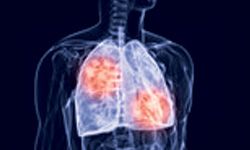Frontline Tislelizumab Combination Significantly Improves PFS in Nonsquamous NSCLC
The combination of tislelizumab, a PD-L1 antibody, pemetrexed and platinum-based chemotherapy achieved a statistically significant prolongation in progression-free survival compared with pemetrexed and platinum chemotherapy alone as first-line treatment of patients with nonsquamous non–small cell lung cancer, meeting the primary end point of a phase III BGB-A317-304 trial.

The combination of tislelizumab (BGB-A317), a PD-L1 antibody, pemetrexed and platinum-based chemotherapy achieved a statistically significant prolongation in progression-free survival (PFS) compared with pemetrexed and platinum chemotherapy alone as first-line treatment of patients with nonsquamous nonsmall cell lung cancer (NSCLC), meeting the primary end point of a phase III BGB-A317-304 trial (NCT03663205), BeiGene announced in a press release.1
“We are excited to announce the positive outcome in the interim analysis of this Phase 3 study of tislelizumab in first-line nonsquamous NSCLC, following the positive interim analysis in first-line squamous NSCLC earlier this year,” said Yong (Ben) Ben, MD, chief medical officer, Immuno-Oncology at BeiGene. “These results add to our growing body of evidence demonstrating the efficacy and safety of tislelizumab for the treatment of advanced cancers. We look forward to continuing to evaluate tislelizumab in more than 25 studies, including 15 potentially registration-enabling trials.”
The planned interim analysis was assessed by an Independent Review Committee. In the analysis, tislelizumab plus pemetrexed and platinum chemotherapy also demonstrated a safety profile that was consistent with the known risk of each agent used in the study.
BGB-A317-304 is an ongoing open-label, multicenter, randomized trial in which 335 patients will be randomized 2:1 to receive 200 mg of tislelizumab every 3 weeks in combination with 500 mg/m2of pemetrexed, along with the investigator’s choice of platinum-based chemotherapy. In the comparator arm, patients receive pemetrexed with carboplatin or cisplatin alone. The secondary end points of the study are overall survival and safety.
The study began enrollment in July 2018 with plans to complete enrollment in September 2020.
Individuals are eligible for the study with a pathological or clinical diagnosis of advanced NSCLC, an ECOG Performance Status ≤ 1, at least 1 measurable lesion, no prior systemic chemotherapy for advanced or metastatic nonsquamous NSCLC, a life expectancy of at least 12 weeks, and adequate organ function.
Patients withEGFR-sensitizing mutation orALKgene translocation, clinically relevant pericardial effusion, history of interstitial lung disease, non-infectious pneumonitis or uncontrolled systemic diseases, severe infection, human immunodeficiency virus infection, untreated hepatitis B or C, active or historic autoimmune disease are excluded from the study. BGB-A317-304 also excludes patients with prior systemic anticancer therapy within 28 days, treatment with EGFR inhibitors or ALK inhibitors, and therapies targeting PD-1 or PD-L1.
Safety and efficacy results from a phase III cohort treated with this combination were presented at the 2019 World Conference on Lung Cancer by Jei Wang, MD, MS of Duke Cancer Center. In this phase, 48 patients received the combination regimen at a median of 3 cycles (range, 1-7). At the time of data cutoff, 44 patients remained in the study.2
The best overall response observed in the cohort was a partial response (PR). Of the 9 patients in the nonsquamous NSCLC cohort receiving tislelizumab plus pemetrexed and platinum chemotherapy, a confirmed PR was observed in 1 (11.1%) patient, and unconfirmed PRs were seen in 3 patients (33.3%). In addition, 3 patients (33.3%) had stable disease, and 1 patient had progressive disease.
Tislelizumab combinations in the phase II study led to treatment-related adverse events (AEs), which were mostly chemotherapy-related hematologic toxicities. The most common grade ≥3 treatment-related AEs were neutropenia (20.8%) and anemia (12.5%). In terms of grade 3 immune-related AEs, the most common were pyrexia (6.3%) and rash (6.3%).
These early findings signaled that tislelizumab in combination with pemetrexed and platinum chemotherapy has antitumor activity in patients with nonsquamous NSCLC. The interim phase III data show continued efficacy.1
“NSCLC is a debilitating disease that comprises approximately 85 percent of lung cancer cases globally. It is estimated that approximately 60 percent of lung cancer diagnoses are made when the disease is in advanced stages and patients need more treatment options. The positive outcome at interim analysis for tislelizumab in this study and in other clinical trials, including for first-line squamous NSCLC, demonstrate that it is a promising option for people living with this advanced cancer,” said Shun Lu, MD, professor at Shanghai Chest Hospital, Jiao Tong University and lead investigator for the trial.
References
- BeiGene announces that the phase 3 trial of tislelizumab combined with chemotherapy in patients with first-line non-squamous non-small cell lung cancer met the primary endpoint of progression-free survival at interim analysis [news release]. Beijing, China and Cambridge, Massachusetts: BeiGene, Ltd; April 13, 2020. https://bit.ly/2XBnqRW. Accessed April 14, 2020.
- Wang J, Zhao J, Wang Z, et al. Tislelizumab combined with chemotherapy as first-line treatment in chinese patients with advanced lung cancer. resented at: IASLC 2020 World Conference on Lung Cancer; September 7-10, 2019; Barcelona, Spain. Abstract P1.04-36.
Bispecific Antibodies and ADCs Deliver a Futuristic Horizon Across Lung Cancer Settings
October 23rd 2024Recent advancements in protein engineering, especially antibody-drug conjugates, show promise in lung cancer treatment, with ivonescimab outperforming pembrolizumab in PD-L1-positive advanced non-small cell lung cancer.
Read More